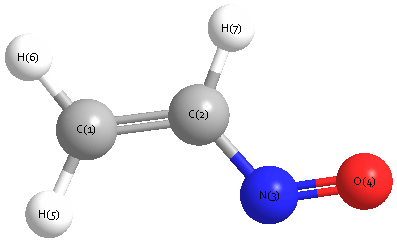Vibrational Frequencies calculated at B1B95/daug-cc-pVTZ
| Mode Number |
Symmetry |
Frequency
(cm-1) |
Scaled Frequency
(cm-1) |
IR Intensities
(km mol-1) |
Raman Act
(Å4/u) |
Dep P |
Dep U |
|---|
| 1 |
A' |
3275 |
3275 |
0.38 |
58.48 |
0.66 |
0.80 |
| 2 |
A' |
3185 |
3185 |
4.47 |
174.53 |
0.13 |
0.23 |
| 3 |
A' |
3168 |
3168 |
2.75 |
18.74 |
0.49 |
0.66 |
| 4 |
A' |
1704 |
1704 |
7.05 |
29.81 |
0.05 |
0.09 |
| 5 |
A' |
1632 |
1632 |
138.76 |
94.21 |
0.37 |
0.54 |
| 6 |
A' |
1415 |
1415 |
23.87 |
21.11 |
0.38 |
0.55 |
| 7 |
A' |
1285 |
1285 |
2.41 |
7.80 |
0.25 |
0.41 |
| 8 |
A' |
1153 |
1153 |
77.11 |
26.73 |
0.40 |
0.57 |
| 9 |
A' |
899 |
899 |
28.03 |
0.32 |
0.64 |
0.78 |
| 10 |
A' |
616 |
616 |
1.52 |
9.40 |
0.10 |
0.18 |
| 11 |
A' |
345 |
345 |
1.15 |
0.70 |
0.67 |
0.80 |
| 12 |
A" |
1019 |
1019 |
6.70 |
3.49 |
0.75 |
0.86 |
| 13 |
A" |
1009 |
1009 |
47.89 |
0.28 |
0.75 |
0.86 |
| 14 |
A" |
690 |
690 |
1.07 |
0.72 |
0.75 |
0.86 |
| 15 |
A" |
178 |
178 |
0.08 |
0.26 |
0.75 |
0.86 |
Unscaled Zero Point Vibrational Energy (zpe) 10785.4 cm
-1
Scaled (by 1) Zero Point Vibrational Energy (zpe) 10785.4 cm
-1
See section
III.C.1 List or set vibrational scaling factors
to change the scale factors used here.
See section
III.C.2
Calculate a vibrational scaling factor for a given set of molecules
to determine the least squares best scaling factor.
Charges, Dipole, Quadrupole and Polarizability
Charges from optimized geometry at B1B95/daug-cc-pVTZ
Charges (e)
| Number |
Element |
Mulliken |
CHELPG |
AIM |
ESP |
| 1 |
C |
-1.427 |
|
|
|
| 2 |
C |
-0.243 |
|
|
|
| 3 |
N |
-0.400 |
|
|
|
| 4 |
O |
-0.678 |
|
|
|
| 5 |
H |
0.668 |
|
|
|
| 6 |
H |
0.605 |
|
|
|
| 7 |
H |
1.475 |
|
|
|
Electric dipole moments
Electric dipole components in Debye
(What's a Debye? See section
VII.A.3)
| |
x |
y |
z |
Total |
| |
1.410 |
2.909 |
0.000 |
3.233 |
| CHELPG |
|
|
|
|
| AIM |
|
|
|
|
| ESP |
|
|
|
|
Electric Quadrupole moment
Quadrupole components in D Å
| Primitive |
|---|
| | x | y | z |
|---|
| x |
-22.667 |
-0.010 |
0.000 |
| y |
-0.010 |
-23.335 |
0.000 |
| z |
0.000 |
0.000 |
-23.700 |
|
| Traceless |
|---|
| | x | y | z |
|---|
| x |
0.851 |
-0.010 |
0.000 |
| y |
-0.010 |
-0.151 |
0.000 |
| z |
0.000 |
0.000 |
-0.699 |
|
| Polar |
|---|
| 3z2-r2 | -1.399 |
|---|
| x2-y2 | 0.668 |
|---|
| xy | -0.010 |
|---|
| xz | 0.000 |
|---|
| yz | 0.000 |
|---|
|
Polarizabilities
Components of the polarizability tensor.
Units are
Å
3 (Angstrom cubed)
Change units.
| |
x |
y |
z |
| x |
7.326 |
1.998 |
0.000 |
| y |
1.998 |
6.999 |
0.000 |
| z |
0.000 |
0.000 |
3.848 |
<r2> (average value of r
2) Å
2
| <r2> |
75.245 |
| (<r2>)1/2 |
8.674 |
